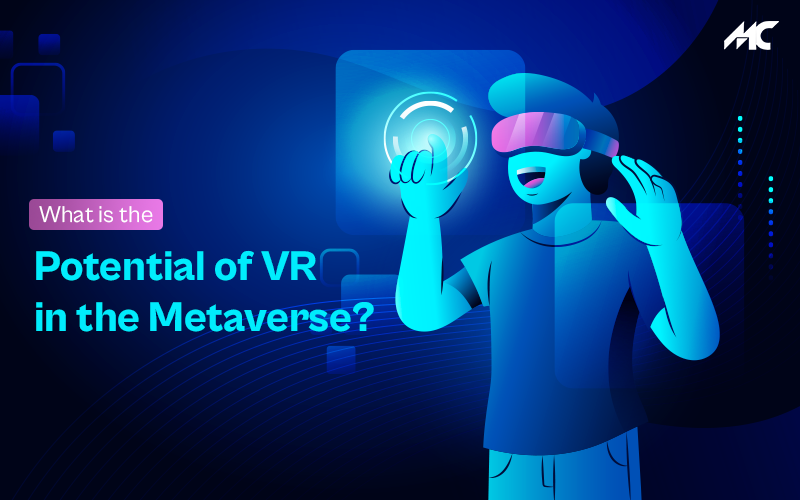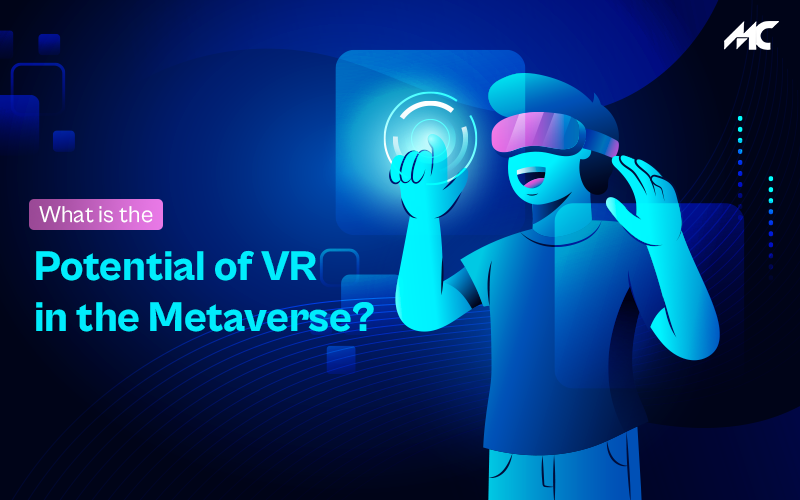The Role of VR in the Metaverse?
With Mark Zuckerberg renaming his company into Meta, the Metaverse is now more than an IT buzzword now. In fact, top businesses are already investing heavily in this emerging virtual reality technology to innovate their products and services. Moreover, VR in Metaverse is set to create a massive impact on our daily lives and how we interact with the digital world.
The Metaverse is focused on mimicking the characteristics of the real world in the digital space. Furthermore, interactions with this world will go beyond just mouse, keywords, or screen. VR in Metaverse will be completely changing the way we consume content on a daily basis. In this blog, we are going to discuss the potential of VR in Metaverse.
Before diving into an in-depth discussion, we must understand the concept of the Metaverse in detail.
What is a Metaverse?
In today’s internet, the user experience is quite confined to input devices like touchscreen, keyboard and mouse, and digital screens. Thus, the user experience is limited and not that interactive.
In a Metaverse, the users can have realistic digital-world experiences by using a VR headset and interactive web content. Thus, they can buy digital products, play videos, and games, socialize with people, and consume interactive media in this virtual world.
We can take the liberty to say that the Metaverse is not a technology, instead, it is an innovative vision of engaging with the digital and real world. In fact, Metaverse could be the best attempt in trying to remove the difference between the real and the virtual world.
Mark Zuckerberg isn’t the first person to coin the term ‘Metaverse’ to the public. In fact, the concept has been there for a long time. However, the vision and goals of the metaverse may differ from company to company. Still, the main idea of the Metaverse lies in a real-time rendered 3D world where multiple users can interact with each other.
Development of the Metaverse
The development of a Metaverse is highly dependent and influenced by advancements in technologies such as virtual reality, augmented reality, artificial intelligence, Blockchain, etc. Thus, it is still a concrete concept in today’s digital world. However, big players like Facebook, Microsoft, Nvidia, and Apple are investing heavily in VR in Metaverse and Blockchain development.
Rules of the Metaverse
There are certain rules which must be followed by the businesses trying to implement their own version of the Metaverse.
- There should be one single version of the metaverse if we want the actual Metaverse.
- The Metaverse should be available to use for everyone.
- No single authority or individual should be able to control the Metaverse.
- The Metaverse should remain open without any downtime.
- The Metaverse must be hardware-independent/agnostic.
- The Metaverse will be dependent on the internet or a network.
So, we have understood the definition and core rules of the Metaverse. Now, we should also understand the six main characteristics that will help you define the Metaverse.

1. Identity
The digital representation of an individual completely depends on the user. Above all, they can express themselves better by creating their own unique avatar. From head to toe, they can define the individual aspects of the character’s look and appearance.
2. Multi-Device Support
The main purpose behind metaverse is to provide maximum availability to the users. Thus, the Metaverse should be easily accessible from anywhere and on any device. In fact, it should be accessible from any phone, tablet, PC, or other device. However, the implementation of VR technology into the Metaverse would be the greatest leap towards an immersive experience.
3. Immersive Experience
We all know that a truly immersive experience includes the sensations of sight, touch, smell, hearing, and taste. The 7D movie theaters greatly provide such an experience by vibrating the chairs, controlling the temperature, or throwing sprinklers of water.
Thus, using VR technology with the Metaverse will be helpful for mimicking the images and sounds of the real world. Furthermore, the next-generation VR headsets are expected to be shipped with haptic bodysuits and omnidirectional treadmills.
Together, these extensions in the VR technology will give physical sensations via electro-stimulation as the users navigate in a digital environment.
4. Digital Economy
A fully interactive Metaverse is meant to have its own functioning economy separate from the real world. In fact, this digital economy would provide opportunities to the users to earn and spend in digital or fiat currencies. Roblox is an amazing example of a Metaverse implementing its own digital economy. Thus, implementing VR into such an interactive environment will make the virtual economy appear almost real.
5. Community-Powered
A Metaverse is a concept of next-generation instructiveness and digital communication. Thus, it will be built on a huge community that can interact and share experiences with each other. We can already see this engagement in interactive video games that share some characteristics of the Metaverse.
6. Persistent with Real-Time
Open-world video games can be paused by the users. However, this is not the case with the concept of the Metaverse. This virtual world will be real-time persistent without having the ability to pause the game. In fact, the Metaverse will continue to exist even when the users leave the digital experience.
Why Does Metaverse Need VR/AR Technology?
As discussed before, VR/AR technologies will be the major extension of the Metaverse. In fact, they will be adding real immersive elements to the virtual environment of the Metaverse. VR in Metaverse will be very helpful in breaking the difference between the virtual and the physical world.
Sensory experiences can also be achieved with the help of VR in Metaverse. It will be just like touching a specific object or walking within the real or virtual world. Moreover, we can add immersive elements to the Metaverse world with AR technologies. Consulting a Blockchain development company can help you prepare for the Metaverse.
Importance of VR/AR for Metaverse Development
The digital world that we know today is mainly based on the interaction with screens and input devices like touchscreens, buttons, keyboards, etc. However, Virtual Reality provides a more promising interactive 3D environment. Users can ensure better telepresence when they use VR technology in an immersive Metaverse.
VR is already very effective in blurring the line between the real and the virtual world. There are so many games that give an almost life-like experience with incredible graphics and sound effects.
Bringing Metaverse and VR together can certainly change the way we would explore virtual locations like schools, concerts, parks, theaters, etc. Users are gonna have a real sense of presence in a virtual place while using the Metaverse. Collaboration and communication with people in the virtual world will feel more realistic and natural with the inclusion of VR/AR technologies.
Real-Life Examples of Some VR Apps
- Popular fashion brands like Tommy Hilfiger are offering a 360-degree experience of their fashion shows organized across the world. Thus, the users can just plug in a VR headset and be a part of the audience watching the fashion shows. This could be a great case study of VR technology in the fashion industry of the Metaverse.
- The famous shoe company Toms is using VR technology to launch its donation campaign online. Donation is given to children in the form of a pair of shoes with every new pair of shoes purchased by the customers. A partner company will be traveling around the world to donate the shoes directly. Thus, a VR experience has been built to invite the customers to virtually join this charitable trip. Through an interactive experience, the attendees can even virtually see the recipients and their living conditions.
- The Tilt Brush allows its users to paint in the 3D space with the help of virtual reality technology. Thus, the users can go beyond the limitations of the 2D canvas to unleash their creativity in the 3D space.
- There are hundreds of VR apps that allow users to just, hang out, and interact with each other. This is a great example of interactive communication with the help of VR technology.
- Metaverse worlds like Decentraland and the Sandbox will take the use of VR technologies to the next level.
Evolution of VR Devices

The VR in Metaverse will open up new opportunities for businesses and individuals around the world. However, the current hardware and software might not be enough to simulate a truly immersive and realistic virtual world. We will certainly need a lot of development in the Virtual Reality technology to improve its capabilities for the Metaverse. Some of the features and changes could be a major step forward in VR technology;
Haptic Body Suits
Wearing a VR headset on your head might not be enough to give you sensory interactions. Therefore, future VR devices will come with a vest, full-body, or gloves to provide a sense of touch with vibration motors and electro-simulations. As users start to explore the virtual world, these suits will provide sensations like the real world.
Omnidirectional Treadmills
Walking itself is a very engaging and interactive activity. In fact, you have to constantly optimize your center of balance to avoid falling. Using omnidirectional treadmills will enable the users to bring their physicality to the virtual world. Moreover, the future omnidirectional treadmills will allow people to walk, run, or even jump in the VR experience.
Brain-Sensing Devices
Using any input device such as keywords, mouse, touchscreen, or motion controller is not truly interactive. Imagine a virtual world where users can control things in real-time by using their neural signals in digital inputs. Such concepts would require highly advanced machine learning algorithms to process brain activity and understand the active visual focus. Ultimately, the users will be able to move an object in focus in the virtual world.
Differentiating Between VR and the Metaverse
There’s often a misconception that VR and the Metaverse are the same things. However, there’s a huge difference between the two concepts. VR is an interactive technology that works as an extension of the Metaverse. Above all, it ensures better telepresence in the virtual world.
The Metaverse, on the other hand, is a much wider concept that aims to mimic the real world into a truly immersive world. It will enable people from all around the world to connect with each other. The Metaverse will function as a virtual, shared, and multifunctional universe. Essentially, Metaverse will bridge the gap between the physical and virtual world. It will also ensure better transparency and security for the users. Whereas, VR will be merely responsible for extending this virtual world into a more interactive and immersive experience.
Summing Up
Just like the Internet in the 80s or 90s, the concept of the Metaverse is still in its infancy. However, top organizations are investing heavily in Blockchain app development to take full advantage of the Metaverse in the future. Thus, this shows the potential of the Metaverse for businesses and individuals. This virtual world will be very immersive and have a real-time persistent economy. Thus, it would be highly advisable to prepare you to become a Metaverse-ready company. MobileCoderz is a prominent Blockchain development company that can digitally transform your business and prepare you for the Metaverse.
-

 Mobilecoderz Awarded as India’s Best iPhone App Development Company by Clutch
Mobilecoderz Awarded as India’s Best iPhone App Development Company by Clutch -

 How Much Does It Cost to Develop a SaaS Application?
How Much Does It Cost to Develop a SaaS Application? -

 Mobilecoderz recognized as the Top App Development Company in Saudi Arabia by GoodFirms
Mobilecoderz recognized as the Top App Development Company in Saudi Arabia by GoodFirms












